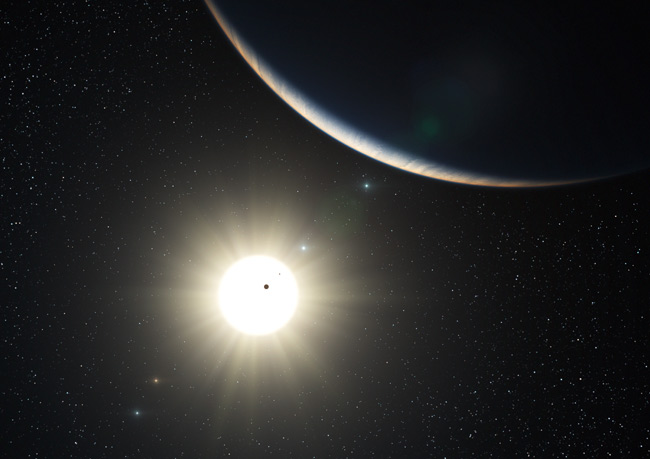Alien Solar System Looks Strikingly Like Ours

Astronomershave discovered a group of at least five planets ? with hints of two more ?circling around a star in an arrangement similar to our own solar system. Confirmationof the extra planets would make this the highest tally of alien worlds everspotted around a single star.
The planets and their own sun-like star are about 127 light-years from Earth,astronomers with the European Southern Observatory said. It is one of just 15planetary systems known to have more than three worlds.
Thefive planets circle their parent star, HD 10180, in a regular pattern like theplanets of our solar system, only in a more compact arrangement, theresearchers said.
Ofthe two potential additional planets that may be present, one may have a massthat is the closest to the Earth's yet seen, if it is confirmed, they added. [The Strangest AlienPlanets]
"We have found what ismost likely the system with the most planets yet discovered," astronomerChristophe Lovis, lead author of the study, said in a statement Tuesday. "This remarkablediscovery also highlights the fact that we are now entering a new era inexoplanet research: the study of complex planetary systems and not just ofindividual planets.
"Studies of planetarymotions in the new system reveal complex gravitational interactions between theplanets and give us insights into the long-term evolution of the system."
The research was announced atan internationalcolloquium on extrasolarplanets at the Observatoire de Haute-Provence, France. It camejust days ahead of a scheduled announcement from NASA's Kepler planet-huntingmission to discuss an "intriguingplanetary system."
Get the Space.com Newsletter
Breaking space news, the latest updates on rocket launches, skywatching events and more!
Lovisand his team used the planet-hunting HARPS spectrograph instrument on a3.6-meter telescope at the European Southern Observatory in La Silla, Chile, todetect the system in the constellation Hydrus.
Theinstrument allows astronomers to measure the movement, or "wobble," ofa star caused by the gravitational pull of planets orbiting around it.
Thefive strongest wobble signals were caused by planets with masses similar toNeptune, between 13 and 25 times the mass of the Earth.
Thoughthese planets are relatively large, they are located close to their parent starand race around at intervals that range from just six days to 600 days.
Theclosest planet is not quite 5.6 million miles (9 million km) from HD 10180,compared to the 93 million miles (150 million km) separating Earth from the sun,a distance also known as an astronomical unit. The distance of the farthest onefrom its star is about 1.4 AU.
?Whencompared to our solar system, all of these planets would fit inside the orbitof Mars and appear to have nearly circular orbits.
Thewobble method for detecting alien planets also suggested more worlds areorbiting HD 10180, one of them up close and the other far off.
"Wealso have good reasons to believe that two other planets are present," Lovis said.
Oneof these extra planets, if confirmed, would be much like Saturn, with at least 65times the mass of Earth and year that lasts 2,200 days.
Theother potential planet is the most tantalizing for astronomers. If confirmed, itwould be the least massive world ever found outside our solar system, with amass just 1.4 times that of Earth. It is thought to orbit extremely close tothe star ? just 2 percent of an AU ? and completes its circuit inonly 1.18 Earth days, researchers said.
"This object causes a wobble of its star of only about3 km/hour? slower than walking speed ? and this motion is very hardto measure,"said study team member Damien S?gransan.
Thisplanet would probably be a small, rocky world similar to the hellish planetCorot-7b, which orbits close to a different star. There the daytimetemperatures can reach 4,000 degrees Fahrenheit (2,200 degrees Celsius), with nighttimelows of minus 350 F (minus 210 C).
Thenewly found system could set the extrasolar record for most known planets. Itcurrently shares the record with the system around the star 55 Cancri, whichhas five planets, two of them gas giants.
Nogas giants seem to be present in the HD 10180 star system.
"Systems of low-mass planets like the one around HD10180 appear to be quite common, but their formation history remains a puzzle," Lovis said.
- Gallery - StrangestAlien Planets
- Top10 Extreme Planet Facts
- NASAto Reveal Big News From Planet-Hunting Spacecraft Thursday
Join our Space Forums to keep talking space on the latest missions, night sky and more! And if you have a news tip, correction or comment, let us know at: community@space.com.

Tariq is the Editor-in-Chief of Space.com and joined the team in 2001, first as an intern and staff writer, and later as an editor. He covers human spaceflight, exploration and space science, as well as skywatching and entertainment. He became Space.com's Managing Editor in 2009 and Editor-in-Chief in 2019. Before joining Space.com, Tariq was a staff reporter for The Los Angeles Times covering education and city beats in La Habra, Fullerton and Huntington Beach. In October 2022, Tariq received the Harry Kolcum Award for excellence in space reporting from the National Space Club Florida Committee. He is also an Eagle Scout (yes, he has the Space Exploration merit badge) and went to Space Camp four times as a kid and a fifth time as an adult. He has journalism degrees from the University of Southern California and New York University. You can find Tariq at Space.com and as the co-host to the This Week In Space podcast with space historian Rod Pyle on the TWiT network. To see his latest project, you can follow Tariq on Twitter @tariqjmalik.









